Facebook
Twitter
WhatsApp
A velvet intimacy develops between carnival revelers, dancers concealed behind clown-white face paint, and Elizabethan collars. Graphic techniques found in mid-century design merge with urgent poses inspired by the work of Otto Dix to present Dionysian scenes of dance and embrace. Jean-Pierre Villafañe’s paintings deliver a nonstop party that borrows moments of delight from the history of Western art and culture: women don victory rolls and sausage curls with snarls of red lipstick, and men are equally made up in blue eyeshadow and hennin hats. Sometimes, the two intermingle to form a fluid embrace of faces and attributes, exploring a hybridization of gender that is neutral, nonbinary.
There’s a voyeuristic quality to Villafañe’s work, as if a flashbulb has suddenly captured his dancers in a private moment of motion and pleasure. This decadent, subterranean atmosphere is undermined by the expressions on his creations’ faces—joy, curiosity, adoration. Rather than condemning them for their revelry, Villafañe celebrates them as aspirational figures to be relished and imitated.
Born in 1992, the self-taught artist often leans on his training as an architectural designer to craft compositions that treat limbs, hats, and tresses as repetitive motifs and brick, stucco, and harlequin diamonds as interconnected characters. These architectural elements also help to construct the figures he paints: his revelers are, in a way, an assemblage of archways and pillars, construction elements positioned at deliberate angles to form an outstretched arm or a chiseled cheekbone.
Villafañe’s work is highly formal despite its playfulness. Graphic pieces like Fulano de tal (2021) and Nos seguimos viendo (2021) develop their arrangements through a precise intimacy of shape and color. The artist elaborates: “Dancing choreographies of lines and shapes lie before oblique forms intended to distort perspectives and the reality we inhabit. The architectural language becomes mirrored in dramatically grotesque and delirious bodily features.”1 This delirium, which Villafañe deftly manipulates and emphasizes, recalls our primal desires to dance, embrace, imbibe, and undress—needs that have always existed, and will remain long after our world has been reduced to vibrating lines and dancing color fields.
Note
1. Ryan Waddoups, “Jean-Pierre Villafañe’s Paintings Piece Together Eternal Nights,” Surface, November 8, 2022, https://www.surfacemag.com/articles/jean-pierre-villafane-midnight-menagerie-painting/.
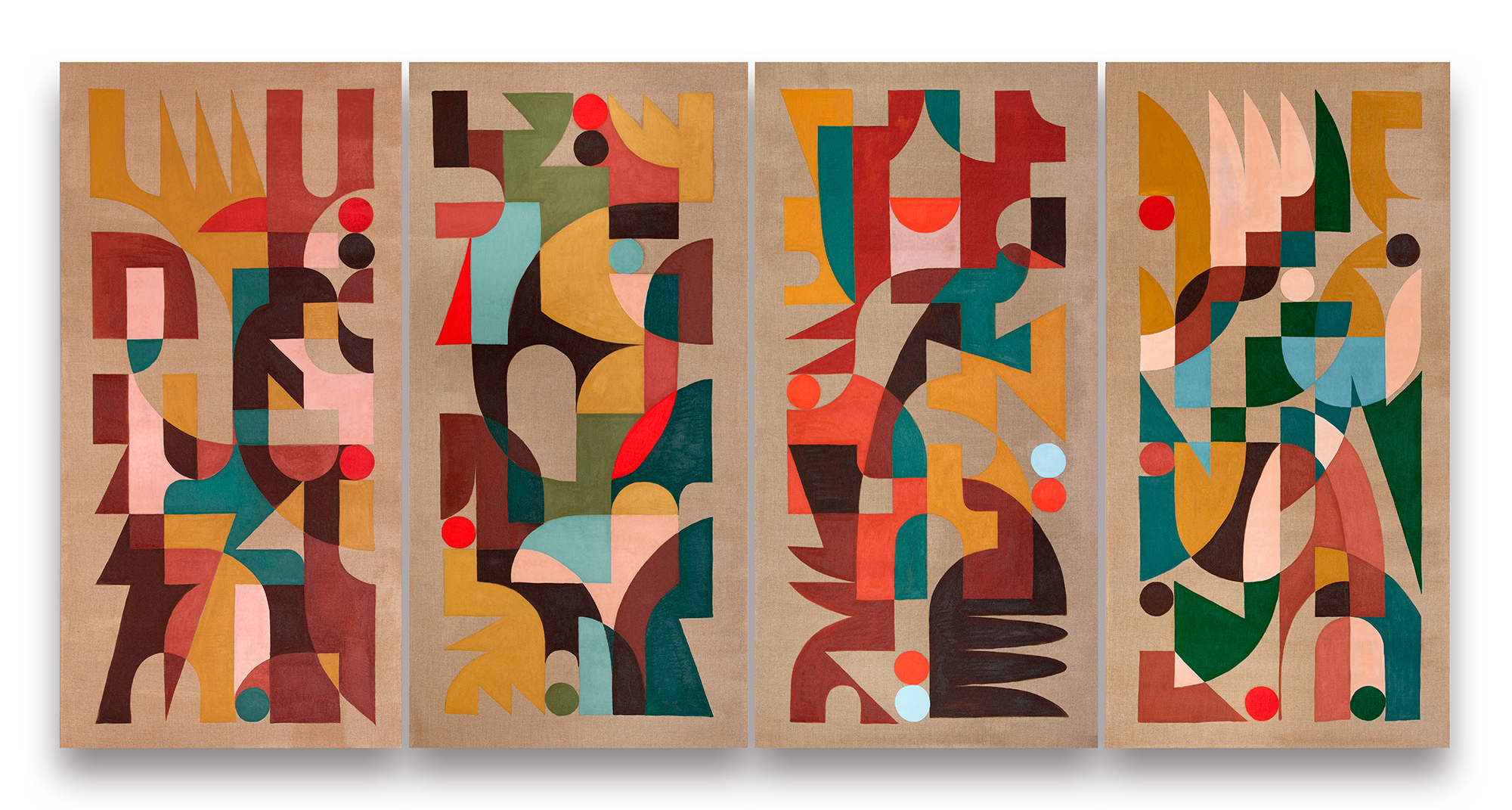
Jean-Pierre Villafañe
Fulano de tal
Nos seguimos viendo
Paseándome como un perro
Tango del tiempo
2021
Oil on linen
40 × 80 in. (each)
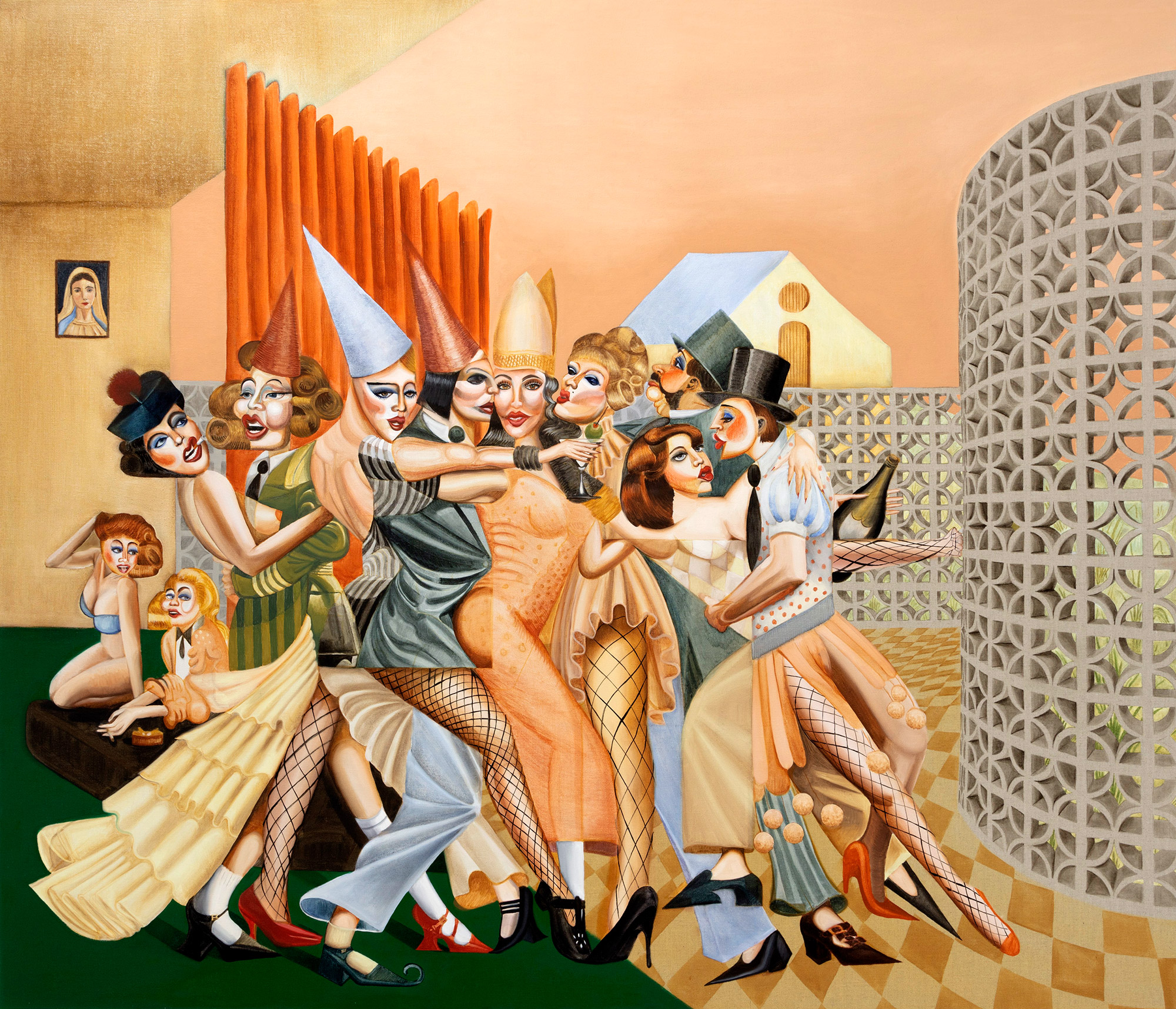
Jean-Pierre Villafañe
Behind the Curtain
2021
Oil on canvas
58 × 68 in.
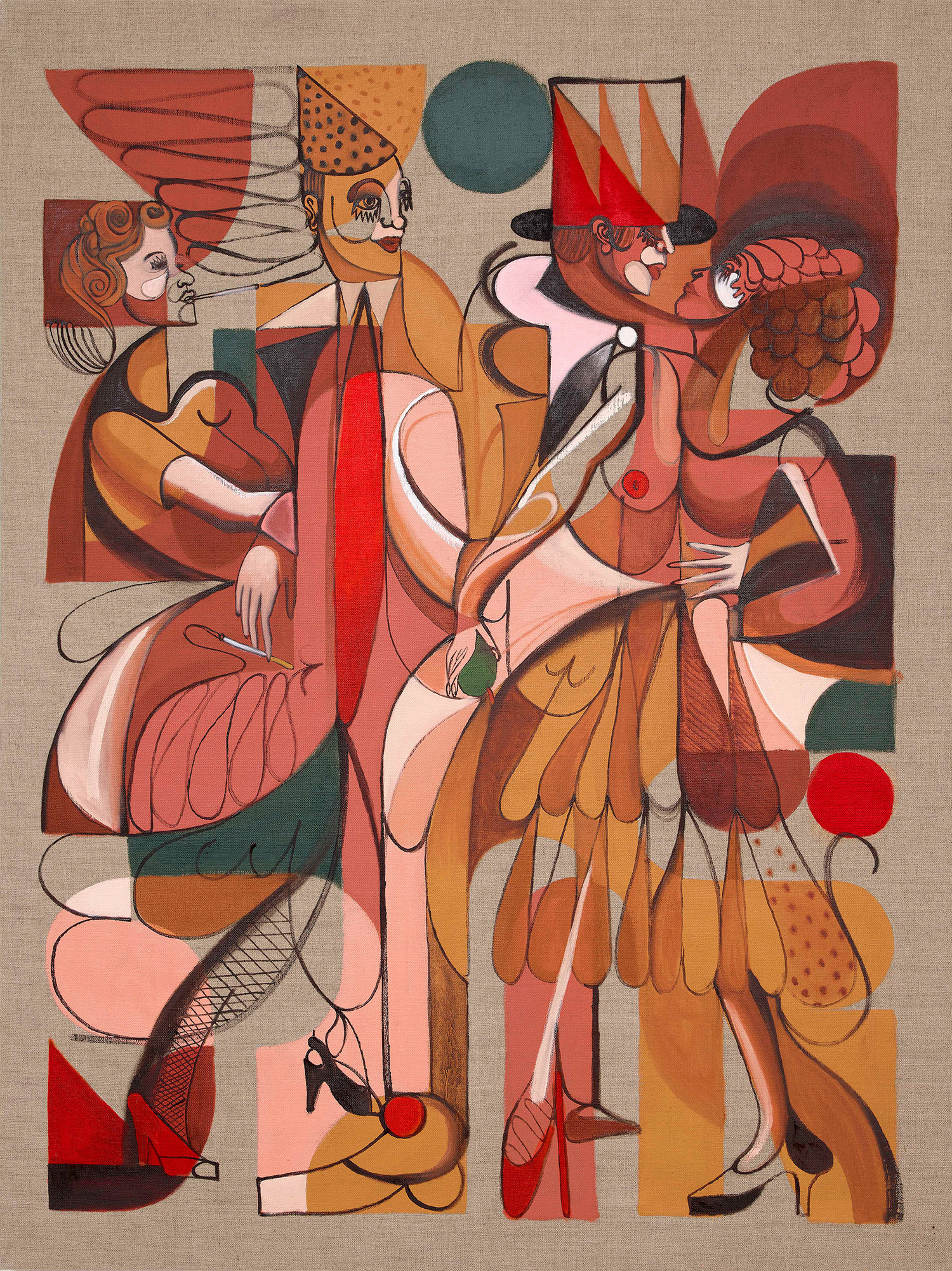
Jean-Pierre Villafañe
La historia de nuestras traiciones
2021
Oil on linen
30 × 40 in.

Jean Pierre Villafañe
Milonga
2021
Oil on linen
30 × 40 in.
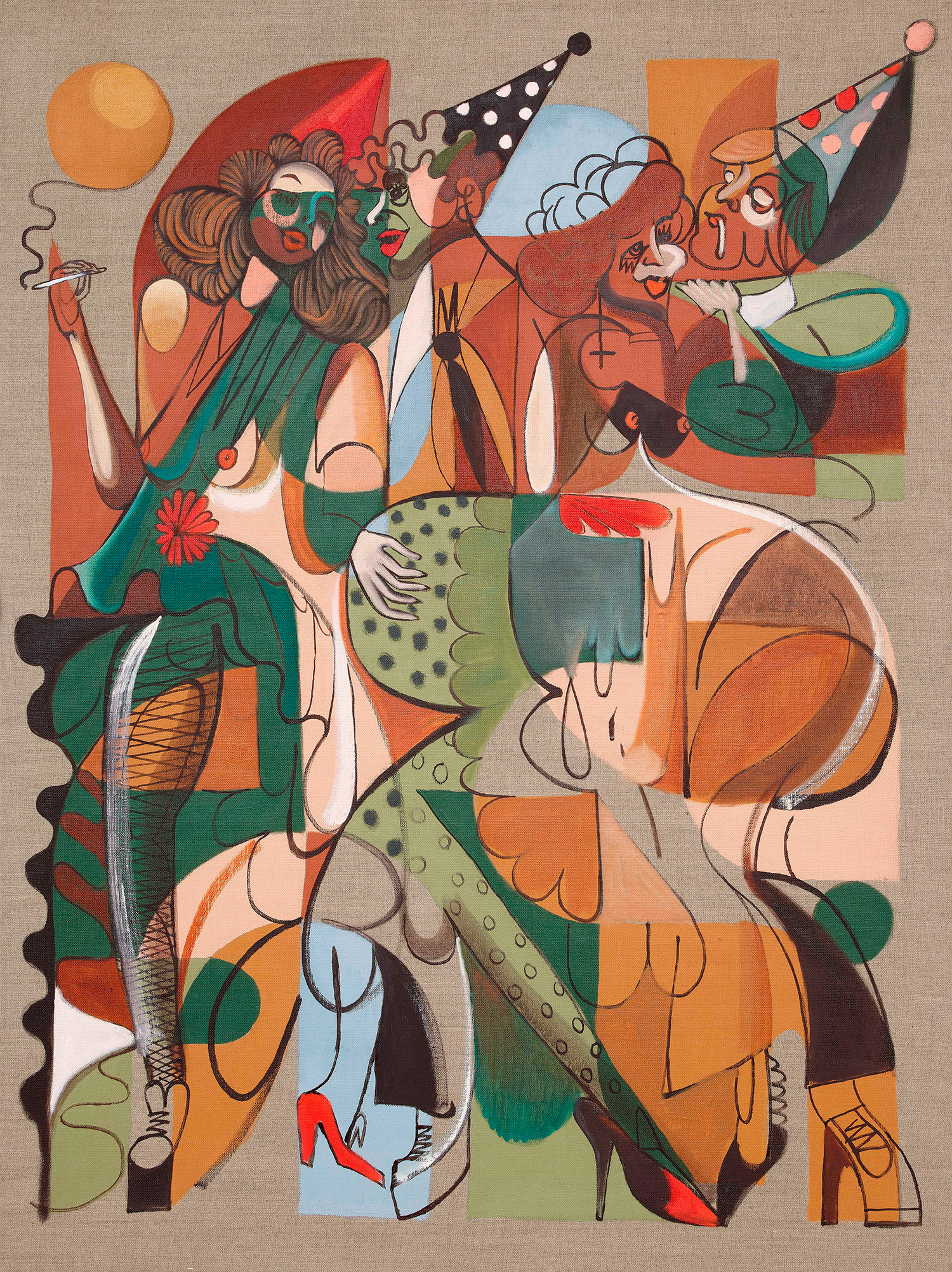
Jean Pierre Villafañe
Sombras
2021
Oil on linen
30 × 40 in.
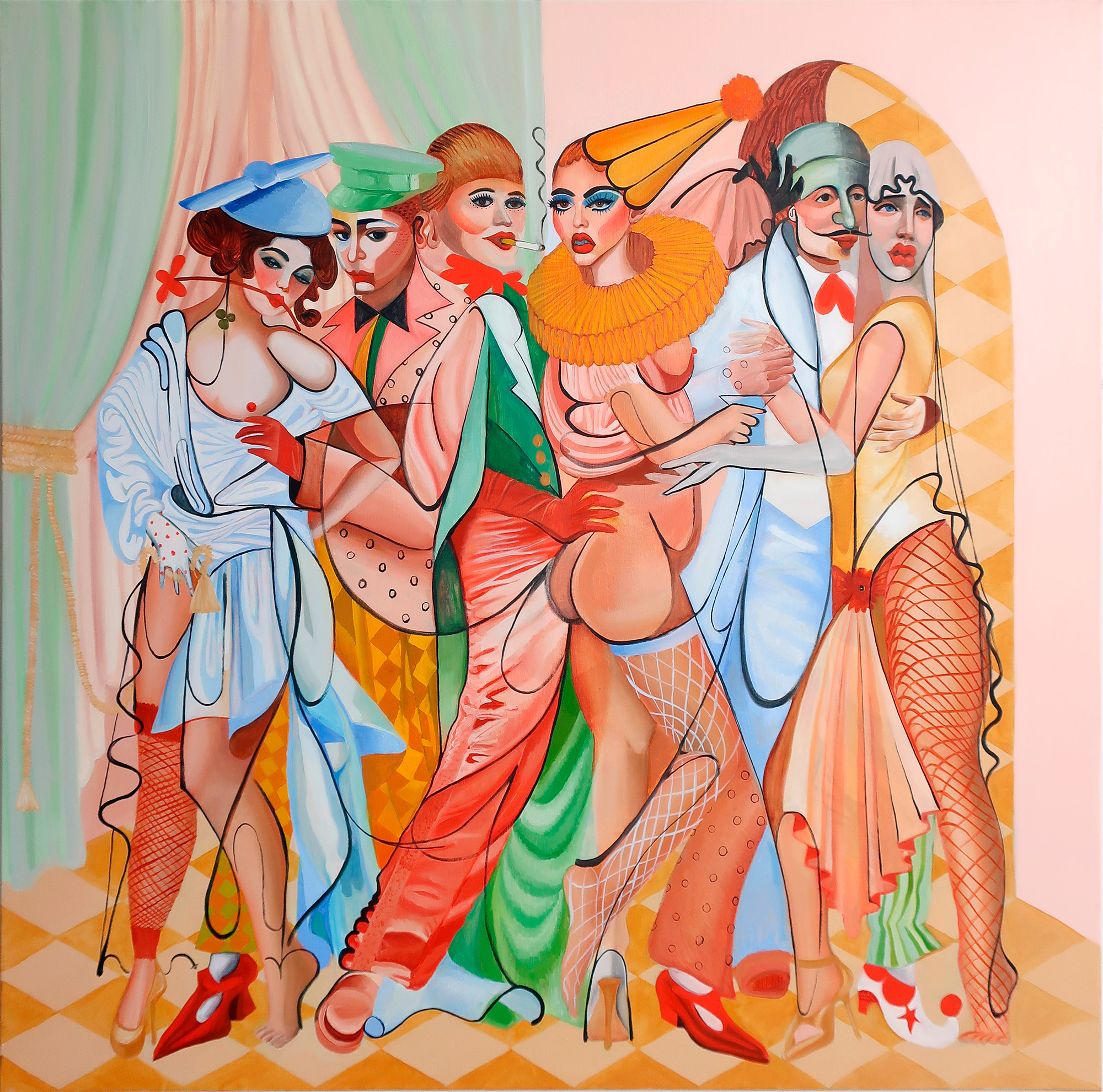
Jean Pierre Villafañe
The Parlor
2021
Oil and graphite on canvas
48 × 48 in.

Jean Pierre Villafañe
The Vestry
2021
Oil and graphite on canvas
40 × 40 in.
A velvet intimacy develops between carnival revelers, dancers concealed behind clown-white face paint, and Elizabethan collars. Graphic techniques found in mid-century design merge with urgent poses inspired by the work of Otto Dix to present Dionysian scenes of dance and embrace. Jean-Pierre Villafañe’s paintings deliver a nonstop party that borrows moments of delight from the history of Western art and culture: women don victory rolls and sausage curls with snarls of red lipstick, and men are equally made up in blue eyeshadow and hennin hats. Sometimes, the two intermingle to form a fluid embrace of faces and attributes, exploring a hybridization of gender that is neutral, nonbinary.
There’s a voyeuristic quality to Villafañe’s work, as if a flashbulb has suddenly captured his dancers in a private moment of motion and pleasure. This decadent, subterranean atmosphere is undermined by the expressions on his creations’ faces—joy, curiosity, adoration. Rather than condemning them for their revelry, Villafañe celebrates them as aspirational figures to be relished and imitated.
Born in 1992, the self-taught artist often leans on his training as an architectural designer to craft compositions that treat limbs, hats, and tresses as repetitive motifs and brick, stucco, and harlequin diamonds as interconnected characters. These architectural elements also help to construct the figures he paints: his revelers are, in a way, an assemblage of archways and pillars, construction elements positioned at deliberate angles to form an outstretched arm or a chiseled cheekbone.
Villafañe’s work is highly formal despite its playfulness. Graphic pieces like Fulano de tal (2021) and Nos seguimos viendo (2021) develop their arrangements through a precise intimacy of shape and color. The artist elaborates: “Dancing choreographies of lines and shapes lie before oblique forms intended to distort perspectives and the reality we inhabit. The architectural language becomes mirrored in dramatically grotesque and delirious bodily features.”1 This delirium, which Villafañe deftly manipulates and emphasizes, recalls our primal desires to dance, embrace, imbibe, and undress—needs that have always existed, and will remain long after our world has been reduced to vibrating lines and dancing color fields.
Note
1. Ryan Waddoups, “Jean-Pierre Villafañe’s Paintings Piece Together Eternal Nights,” Surface, November 8, 2022, https://www.surfacemag.com/articles/jean-pierre-villafane-midnight-menagerie-painting/.

Jean-Pierre Villafañe
Fulano de tal
Nos seguimos viendo
Paseándome como un perro
Tango del tiempo
2021
Oil on linen
40 × 80 in. (each)

Jean-Pierre Villafañe
Behind the Curtain
2021
Oil on canvas
58 × 68 in.

Jean-Pierre Villafañe
La historia de nuestras traiciones
2021
Oil on linen
30 × 40 in.

Jean Pierre Villafañe
Milonga
2021
Oil on linen
30 × 40 in.

Jean Pierre Villafañe
Sombras
2021
Oil on linen
30 × 40 in.

Jean Pierre Villafañe
The Parlor
2021
Oil and graphite on canvas
48 × 48 in.

Jean Pierre Villafañe
The Vestry
2021
Oil and graphite on canvas
40 × 40 in.